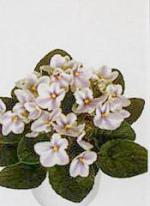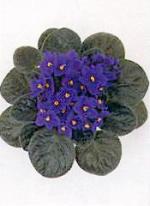|
|
SaintpauliaFamily: Gesneriaceae.
|
Common name(s): African Violet |
|
 |
Genus of about 20 species of low-growing, evergreen perennials found on banks, streamsides, on among rocks, or as epiphytes on trees in a very small area of tropical E. Africa. Most are virtually stemless or have very short stems.
Saintpaulia (African Violet) is a world-wide favourite. Its main attraction is the ability to flower at almost any time of the year and its compact size means it can fit on a narrow windowsill.
There are a some basic needs - steady warmth, careful watering, good light, high air humidity and regular feeding. Keep the leaves off the windowpane. Remove dead flowers and damaged leaves immediately - do not leave a stalk. Remove side shoots on older plants as they develop. Keep the plant moderately root-bound. Use a plastic pot when repotting is essential.
Saintpaulia cultivars are classified by rosette diameter into 5 groups:
- Micro-miniature - Less than 3 in (8 cm)
- Miniature - 3-6 in (8-18 cm)
- Semi-miniature - 6-8 in (15-20 cm)
- Standard - 8-16 in (20-40 cm)
- Large - over 16 in (40 cm)
|
|
| Growing conditions |
Watering and misting |
Propagation |
| Average or above average warmth in summer. Keep fairy cool in winter - minimum temperature 60 F or 18 C. Bright light - avoid direct sunshine. Grow in soilless potting mix. Provide at least 12 hours of light per day for long-term flowering. The diameter of the pot should be one-third the diameter of the plant. Do not overpot. |
Water freely from spring to autumn - sparingly in Winter. Use tepid water. Mist leaves frequently, especially in hot weather. |
Take leaf cuttings in spring. Sow seed at 66-75 F (19-24 C) as soon as ripe. Chimeras will not come true from leaf cuttings, but will come true from suckers or from plantlets borne on flower stalks. |
|
Saintpaulia chimera |
|
|
|
 |
|
Saintpaulia ionantha H. Wendl. |
|
|
|
 |
User-submitted additions and corrections:
Lena
USA
20th Sep 2007
|
I received African Violets as a gift in my job. I never flowered until I bought it home. I have it on my window sill which faces North/North East and all of a sudden it flowered like crazy. Acuatlly, it hasen't stopped since. It just keeps flowering. I water it about once a week. I even bought the food but since I brought it home, I haven't needed it.
I just think that it likes a window facing North. In my job, the window was facing East. Hope that helps. |
Lena
USA
20th Sep 2007
|
Oh yes almost forgot, dont water the leaves. |
Lin
usa
22nd Jan 2008
|
Some of mine bloom all year and some do not. I have most of mine in self-watering AV planters, which I love. I try to purchase different color blooms. They are so easy to care for. I have mine in SW windows. |
robinM
Illinois,USA
20th Oct 2008
|
I know the rule is to root bound your african violet, but, I took a healthy plant that was in a three-inch pot and put it in a six-inch pot and it flowers about three times a year but with so many blooms I cannot count, just remember to make sure that as the plant spreads out that you keep it in the soil |
DebbyM
Nova Scotia, Canada
8th Oct 2010
|
The experts always say don't water the leaves but they must have problem water because when my plants get dusty, I hold them under a tap of lukewarm water or use a gentle spray of lukewarm water on the whole plant and then set it on edge so the water can run off easier and put it on a warm but out of the light spot on the counter and they are fine. It freshens them up and they look great. I've always done this and never gotten leaf spots or crown rot or anything like that. |
Teresa B
Iowa, USA
11th Dec 2011
|
You can rinse the leaves to \"dust\" them occasionally, but NEVER allow wet leaves to get sunlight or they will turn brown/die off... I got sloppy with my watering of African violets in direct sun last summer and almost killed off my babies by getting the leaves wet in the sunshine... They don't really like real intense direct summer sunlight as well... they also like to be watered from the bottom occasionally/ let them suck up water from below, but don't let them have "wet feet"... and I've killed way more of them by over watering than letting them get too dry... |
|
These materials are freely provided for instructional and educational purposes. Any duplication or publication of text or images herein for commercial gain without explicit written permission of the owner or photographer constitutes breach of trust and violation of copyright.
Copyright © Galka Okhapkina 1998-2026



